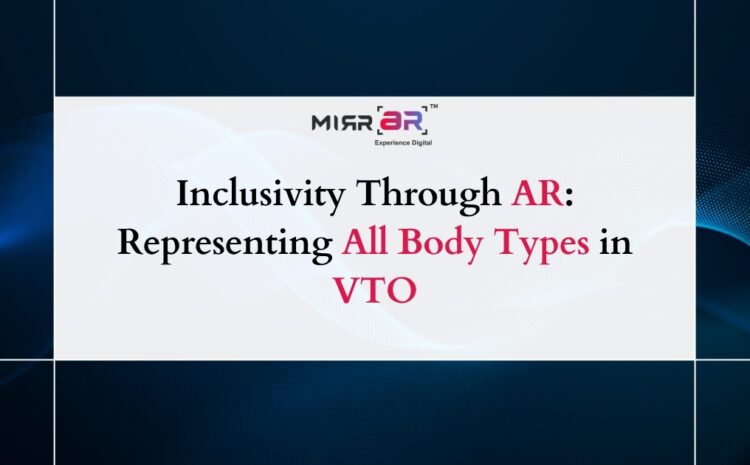In the fast-paced world of online shopping, Virtual Try-On (VTO) technology is changing the way customers interact with brands. By allowing shoppers to visualize products on themselves before making a purchase, VTO reduces uncertainty and boosts confidence in buying decisions. However, as inclusive shopping becomes a growing expectation rather than a luxury, the challenge lies in ensuring that VTO tools cater to all body types—not just a narrow range of sizes. This is where Augmented Reality (AR) can play a powerful role in breaking barriers.
Representing diverse body shapes, sizes, and proportions in AR is not just about improving technology—it’s about building trust and creating a more human-centered shopping experience. Customers are no longer satisfied with one-size-fits-all models; they want to see how products look on bodies that reflect their own. By embracing inclusivity in VTO, brands can connect with a wider audience, foster loyalty, and take a stand for representation in the digital retail space.
Why Inclusivity Matters in Virtual Try-On
The fashion and retail industry has long faced criticism for perpetuating unrealistic beauty standards. Many shoppers have struggled to find accurate product representations online because VTO tools often rely on limited body templates. This exclusion can lead to frustration, lower conversion rates, and a sense that certain customers are not valued by the brand. Inclusivity ensures that every shopper feels seen and represented—no matter their size, height, or proportions.
From a business perspective, inclusivity isn’t just about ethics—it’s a competitive advantage. According to industry reports, brands that embrace diversity in their marketing and product displays often experience higher engagement and sales. When VTO technology incorporates body diversity, it opens the door to new markets and demographics. This approach not only improves customer satisfaction but also drives long-term loyalty in a highly competitive ecommerce landscape.
The Role of AR in Achieving True Representation
Augmented Reality makes it possible to create lifelike, adaptable virtual models that mirror the wide spectrum of human bodies. Unlike traditional static images, AR-powered VTO can dynamically adjust to different measurements and shapes, offering a truly personalized preview. With advancements in 3D scanning and AI-driven body mapping, brands can now create more accurate and inclusive digital avatars for shoppers.
This representation goes beyond size—it includes height variations, different body proportions, and even posture differences. By factoring in these subtle details, AR-powered VTO delivers a far more authentic visualization, helping customers feel confident that the fit and style they see online will match their expectations in real life.
Overcoming Technical and Creative Challenges
Building inclusive VTO systems does present challenges. High-precision body mapping requires significant data input, and ensuring that this data reflects global diversity can be complex. Designers and developers need to collaborate closely, not only to create realistic models but also to maintain smooth performance on various devices. Additionally, there’s the challenge of balancing accuracy with privacy—customers must feel safe sharing their body measurements or using scanning tools.
Creatively, brands must avoid tokenism and instead aim for genuine representation. This means incorporating a full range of sizes and shapes into their VTO tools from the start, rather than adding diversity as an afterthought. Partnering with diverse model groups during the design process can help ensure authenticity and relatability.
The Emotional Impact of Inclusive VTO
Representation is more than a technical feature—it’s an emotional experience for the shopper. When customers see themselves accurately reflected in a brand’s virtual try-on tool, it validates their identity and boosts their confidence. This can lead to a stronger emotional connection with the brand, transforming a one-time purchase into an ongoing relationship.
In a world where online shopping lacks the tactile experience of physical stores, emotions play a crucial role in purchase decisions. Inclusive AR tools bridge this gap by delivering a personalized and affirming experience, making customers feel valued and understood. This human connection is what turns casual browsers into loyal advocates.
The Future of Inclusivity in AR Shopping
The future of AR-powered VTO is one where representation is the default, not the exception. As AI and AR technology continue to evolve, we can expect more sophisticated body scanning, realistic fabric simulations, and even the ability to simulate movement in different outfits. This will further enhance personalization while ensuring inclusivity stays at the core of the experience.
Brands that invest in inclusive AR now will set themselves apart as industry leaders. Beyond the ethical imperative, it’s a strategic move to appeal to an increasingly diverse customer base. By making everyone feel welcome in the virtual fitting room, brands can redefine online shopping as a space that celebrates individuality.
Conclusion
Inclusivity through AR in Virtual Try-On is more than a trend—it’s a necessary shift toward equality and representation in ecommerce. By representing all body types accurately, brands can create a deeper connection with their customers while also driving higher engagement and sales. The combination of advanced AR technology and a commitment to diversity has the power to make online shopping not just more convenient, but more human.
